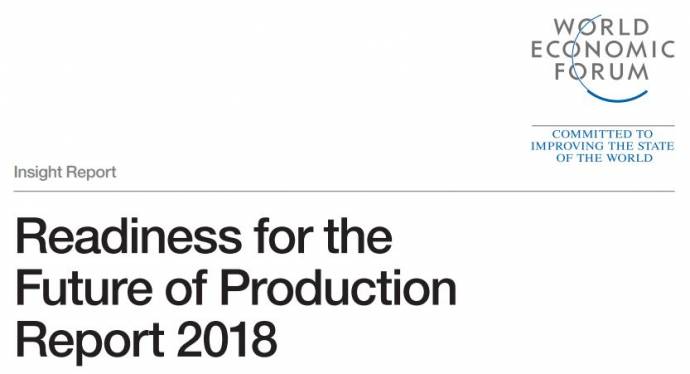January 23, 2018
The STA reports January 23, 2018, that A.T. Kearney, a consultancy, has placed Slovenia among the top 25 countries in the world with regards to their positioning to shape and benefit from the changing nature of production. The list has been released as part of the World Economic Forum in Davos.
The Readiness for the Future of Production Report 2018 (PDF here), a joint report of the World Economic Forum and A.T. Kearney, measures 100 countries based on how well prepared they are for the future of manufacturing production in light of the fourth industrial revolution and emerging technologies that will fundamentally transform production.
The countries are divided into four categories. The leading 25 countries, including Slovenia, have been assessed to have a strong current production base and are mostly future-ready. Ten were categorised as having a strong legacy and strong current production base, but are at risk for the future, while seven have high potential and 58 are developing.
Japan is the leading country in terms of the structure of production, followed by South Korea, Germany, Switzerland and China. The US is considered the driver of production, followed by Singapore, Switzerland, the UK and the Netherlands. Slovenia ranked 21st and 32nd, respectively, in the two categories.
"Slovenia is among the 25 countries that are best prepared for the future of manufacturing production. Individual criteria paint a very colourful picture and show what companies and Slovenia as a country must do to make the best use of this potential," said Branko Žibret, the head of A.T. Kearney's East European branch.
Slovenia fares well in the structure of production and in particular in the economic complexity, where it ranked 12th. This points to the ability to produce unique products as a result of the transfer of know-how into production. But it did not rank very high in the size of production (39th place).
A notable result is the country's fifth place in sustainable management of natural resources.
In the category driver of technology and innovation, Slovenia is 35th, but it ranks third in the subcategory measuring the number of scientific and technical publication, and 22nd in the subcategory number of patent applications per million people.
Meanwhile, the country is well below the global average in terms of government procurement of advanced technology products (91st), FDI and technology transfer (68th), state of cluster development (64th) and venture capital deal volume (60th).
In the human capital category, Slovenia finished 27th overall, but was third in the share of manufacturing workers, 11th in the quality of maths and science education, and 13th in school life expectancy.
It fared much worse in the subcategory of hiring and firing practices (96th), capacity to attract and retain talent (78th) and availability of scientists and engineers (61st).
In global trade and investment, Slovenia placed 40th, ranking 12th in international trade. It meanwhile finished 95th in greenfield investments and 86th in FDI inflows.
Slovenia's institutional framework as the driver of progress puts the country in 27th place, with a particularly low ranking in the subcategory future orientation of government (64th).






